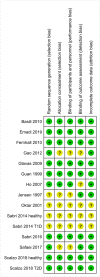Vitamin C May Improve Left Ventricular Ejection Fraction: A Meta-Analysis
- PMID: 35282368
- PMCID: PMC8913583
- DOI: 10.3389/fcvm.2022.789729
Vitamin C May Improve Left Ventricular Ejection Fraction: A Meta-Analysis
Abstract
Background: Vitamin C deprivation can lead to fatigue, dyspnea, oedema and chest pain, which are also symptoms of heart failure (HF). In animal studies vitamin C has improved contractility and mechanical efficiency of the heart. Compared with healthy people, patients with HF have lower vitamin C levels, which are not explained by differences in dietary intake levels, and more severe HF seems to be associated with lower plasma vitamin C levels. This meta-analysis looks at the effect of vitamin C on left ventricular ejection fraction (LVEF).
Methods: We searched for trials reporting the effects of vitamin C on LVEF. We assessed the quality of the trials, and pooled selected trials using the inverse variance, fixed effect options. We used meta-regression to examine the association between the effect of vitamin C on LVEF level and the baseline LVEF level.
Results: We identified 15 trials, three of which were excluded from our meta-analysis. In six cardiac trials with 246 patients, vitamin C increased LVEF on average by 12.0% (95% CI 8.1-15.9%; P < 0.001). In six non-cardiac trials including 177 participants, vitamin C increased LVEF on average by 5.3% (95% CI 2.0-8.5%; P = 0.001). In meta-regression analysis we found that the effect of vitamin C was larger in trials with the lowest baseline LVEF levels with P = 0.001 for the test of slope. The meta-regression line crossed the null effect level at a baseline LVEF level close to 70%, with progressively greater benefit from vitamin C with lower LVEF levels. Some of the included trials had methodological limitations. In a sensitivity analysis including only the four most methodologically sound cardiac trials, the effect of vitamin C was not substantially changed.
Conclusions: In this meta-analysis, vitamin C increased LVEF in both cardiac and non-cardiac patients, with a strong negative association between the size of the vitamin C effect and the baseline LVEF. Further research on vitamin C and HF should be carried out, particularly in patients who have low LVEF together with low vitamin C intake or low plasma levels. Different dosages and different routes of administration should be compared.
Keywords: antioxidant; coronary artery bypass graft surgery (CABG); heart failure; left ventricular function; oxidative stress; percutaneous coronary intervention (PCI); randomized trials; systematic review.
Copyright © 2022 Hemilä, Chalker and de Man.
Conflict of interest statement
The authors declare that the research was conducted in the absence of any commercial or financial relationships that could be construed as a potential conflict of interest.
Figures





Similar articles
-
Impact of left ventricular ejection fraction on clinical outcomes after left main coronary artery revascularization: results from the randomized EXCEL trial.Eur J Heart Fail. 2020 May;22(5):871-879. doi: 10.1002/ejhf.1681. Epub 2020 Feb 11. Eur J Heart Fail. 2020. PMID: 32043709 Clinical Trial.
-
Effect of vitamin D on ventricular remodelling in heart failure: a meta-analysis of randomised controlled trials.BMJ Open. 2018 Aug 30;8(8):e020545. doi: 10.1136/bmjopen-2017-020545. BMJ Open. 2018. PMID: 30166289 Free PMC article.
-
Effects of Ivabradine on Cardiac Remodeling in Patients With Stable Symptomatic Heart Failure: A Systematic Review and Meta-analysis.Clin Ther. 2020 Dec;42(12):2289-2297.e0. doi: 10.1016/j.clinthera.2020.10.005. Epub 2020 Nov 5. Clin Ther. 2020. PMID: 33160681
-
Effects of Exercise after Percutaneous Coronary Intervention on Cardiac Function and Cardiovascular Adverse Events in Patients with Coronary Heart Disease: Systematic Review and Meta-Analysis.J Sports Sci Med. 2019 Jun 1;18(2):213-222. eCollection 2019 Jun. J Sports Sci Med. 2019. PMID: 31191090 Free PMC article.
-
Impact of physiologic pacing versus right ventricular pacing among patients with left ventricular ejection fraction greater than 35%: A systematic review for the 2018 ACC/AHA/HRS guideline on the evaluation and management of patients with bradycardia and cardiac conduction delay: A Report of the American College of Cardiology/American Heart Association Task Force on Clinical Practice Guidelines and the Heart Rhythm Society.Heart Rhythm. 2019 Sep;16(9):e280-e298. doi: 10.1016/j.hrthm.2018.10.035. Epub 2018 Nov 6. Heart Rhythm. 2019. PMID: 30412776
Cited by
-
Preoperative and postoperative administration of vitamin C in cardiac surgery patients - settings, dosages, duration, and clinical outcomes: a narrative review.Ann Med Surg (Lond). 2024 Apr 29;86(6):3591-3607. doi: 10.1097/MS9.0000000000002112. eCollection 2024 Jun. Ann Med Surg (Lond). 2024. PMID: 38846824 Free PMC article. Review.
-
The Influence of High-Dose Parenteral Vitamin C on the Incidence and Severity of Postoperative Pulmonary Complications in Cardiac Surgery with Extracorporeal Circulation: A Randomized Controlled Trial.Nutrients. 2024 Mar 7;16(6):761. doi: 10.3390/nu16060761. Nutrients. 2024. PMID: 38542673 Free PMC article. Clinical Trial.
-
Vitamin C reduces the severity of common colds: a meta-analysis.BMC Public Health. 2023 Dec 11;23(1):2468. doi: 10.1186/s12889-023-17229-8. BMC Public Health. 2023. PMID: 38082300 Free PMC article. Review.
-
Molecular mechanisms of sacubitril/valsartan in cardiac remodeling.Front Pharmacol. 2022 Aug 8;13:892460. doi: 10.3389/fphar.2022.892460. eCollection 2022. Front Pharmacol. 2022. PMID: 36003518 Free PMC article. Review.
-
Vitamin C in Cardiovascular Disease: From Molecular Mechanisms to Clinical Evidence and Therapeutic Applications.Antioxidants (Basel). 2025 Apr 23;14(5):506. doi: 10.3390/antiox14050506. Antioxidants (Basel). 2025. PMID: 40427388 Free PMC article. Review.
References
-
- Lind J. The diagnostics, or signs (Chap. II). In: A Treatise of the Scurvy in Three Parts. Edinburgh: Kincaid A, Donaldson A. (1753). 10.1017/CBO9781107256644 Available online at: https://archive.org/details/b30507054/page/n6/mode/2up (accessed January 8, 2022). - DOI
-
- Hess AF. Pathology; Symptomatology and diagnosis. In: Scurvy: Past and Present. Philadelphia, PA, USA: Lippincott. (1920). p. 81–110, 176–224. Available online at: https://chla.library.cornell.edu; https://archive.org/details/b29823778/page/n4/mode/2up
-
- Crandon JH, Lund CC, Dill DB. Experimental human scurvy. N Engl J Med. (1940) 223:353–69. 10.1056/NEJM194009052231001 - DOI
Publication types
LinkOut - more resources
Full Text Sources
Medical
Research Materials
Miscellaneous

